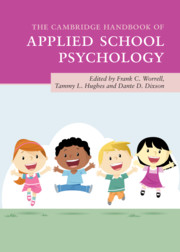Book contents
- The Cambridge Handbook of Applied School Psychology
- The Cambridge Handbook of Applied School Psychology
- Copyright page
- Contents
- Contributors
- Contributor Biographies
- Acknowledgments
- 1 Broadening the Focus of School Psychology Practice
- Part I Individual-Level Academic Interventions
- 2 Enhancing Reading Motivation in Schools
- 3 Addressing “Won’t Do” Issues in Mathematics
- 4 Learning Disabilities in Mathematics
- 5 Executive Function and School Performance
- Part II Teacher- and System-Level Interventions
- Part III Interventions from Educational and Social/Personality Psychology
- Part IV Behavioral and Social-Emotional Interventions
- Part V Health and Pediatric Interventions
- Part VI Family Connections and Life Transitions
- Part VII Special Populations
- Part VIII Conclusion
- Index
- References
2 - Enhancing Reading Motivation in Schools
from Part I - Individual-Level Academic Interventions
Published online by Cambridge University Press: 18 September 2020
- The Cambridge Handbook of Applied School Psychology
- The Cambridge Handbook of Applied School Psychology
- Copyright page
- Contents
- Contributors
- Contributor Biographies
- Acknowledgments
- 1 Broadening the Focus of School Psychology Practice
- Part I Individual-Level Academic Interventions
- 2 Enhancing Reading Motivation in Schools
- 3 Addressing “Won’t Do” Issues in Mathematics
- 4 Learning Disabilities in Mathematics
- 5 Executive Function and School Performance
- Part II Teacher- and System-Level Interventions
- Part III Interventions from Educational and Social/Personality Psychology
- Part IV Behavioral and Social-Emotional Interventions
- Part V Health and Pediatric Interventions
- Part VI Family Connections and Life Transitions
- Part VII Special Populations
- Part VIII Conclusion
- Index
- References
Summary
In order for children to become engaged readers, it is important for them to develop the component reading skills that lead to long-term reading success and to find reading enjoyable. Both reading motivation and skill acquisition are central to reading development and continued growth over time. However, the relationship between these two prerequisites for becoming a lifelong reader is dynamic and bidirectional, suggesting that there are many different opportunities to intervene when children are disengaged or struggling readers. School psychologists can play a role in the prevention of and intervention in both reading and motivational challenges. This chapter includes information about how school psychologists might approach these issues using a tiered systems-of-support framework, while taking the home literacy environment into account.
Keywords
- Type
- Chapter
- Information
- The Cambridge Handbook of Applied School Psychology , pp. 11 - 29Publisher: Cambridge University PressPrint publication year: 2020

